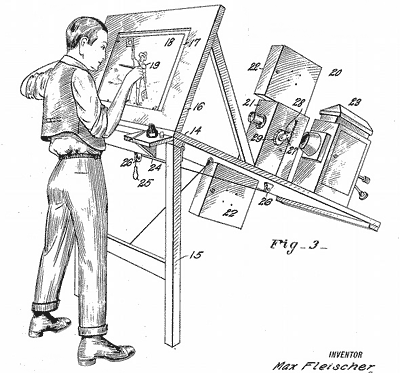The Rotoscope of Max Fleischer
 In this article we will describe the rotoscope through its creator and its current importance in the production budget and quality.
In this article we will describe the rotoscope through its creator and its current importance in the production budget and quality.
From traditional animation technique, the rotoscope consists in the utilization of a film or video of a real character as model for animation. The reasons of using this technique are basically the same of any motion capture technique, in other words, elaborate animations based on animals or people actions and haste the animation process. However, rotoscope has an infinitely smaller price and allows motion capture in locations, where the equipment cannot be present neither accompany the actor in long and complex scenes.
Developed in 1917 and patented two years later, the machine called Rotoscope, created by Max Fleischer and his brother Dave, could project images of a film in an animation table. From there, the actions could be transferred frame by frame and incorporated on animation characters.
Un-resigned with Disney animation model and always in search of new techniques, Max was accomplishing a series of innovations and today is considered a pioneer of animation. Using the rotoscope machine, he was responsible for a realism never seen in an animation film, as in the series Superman in 1941. Soon after, he invented another machine called Rotograph, where he turned possible the inclusion of real scenes as animations background. Fleischer developed also a new methodology where the characters could be placed in a 3D environment. His first film using this technique was ‘Poor Cinderella’, a film of the character Betty Boop and just after with the first coloured animation Popeye.
Without a doubt the rotoscope is the most polemic animation technique of the last times. Since its invention until current days, we can see comments about animation fluidity quality and authorship, once it could be considered a copy of a scene. To guarantee the sales of their animations, several studios deny even today its use. However, the rotoscope has been used for several decades in great movies successes, as “Terminator II”, when the T-1000 leaves the elevator and persecutes the heroes. In this scene, the rotoscope was used so that the 3D character could run like the actor.
In decade of 80’s, the motion capture techniques was an extension of rotoscope. In these techniques the actors actions used to be filmed at the same time in different views and markers placed in the person’s body were manually coded to 3D space. Only at the end of this decade the motion capture systems has been automated to recognize the markers in the person’s body. Nowadays, most of video and animations systems has several resources for rotoscope automation.

